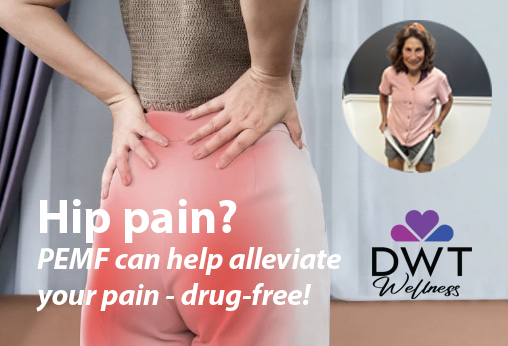
As women move through midlife, many notice new aches and pains—especially around the hips. If you’ve ever felt a deep ache or sharp pain on the outside of your hip when climbing stairs, standing too long, or lying on your side at night, you’re not alone. These are classic signs of gluteal tendinopathy, a common yet often misunderstood condition that affects women most frequently during and after menopause.
At DWT Wellness, we understand how changes in your body during this season of life can affect your mobility, comfort, and confidence. The good news is that there are gentle, drug-free therapies—like PEMF (pulsed electromagnetic field therapy)—that can support your body’s natural healing process and help you move with greater ease.
What Is Gluteal Tendinopathy?
Gluteal tendinopathy occurs when the tendons of the gluteus medius and gluteus minimus—two important stabilizing muscles in your hips—become irritated, weakened, or develop tiny tears.
Typical symptoms include:
- Pain on the outside of the hip, especially when walking, standing, or lying on that side.
- Stiffness or weakness climbing stairs or rising from a chair.
- Tenderness when pressing on the hip area.
This condition is sometimes misdiagnosed as “hip bursitis,” but in most cases, it’s the tendons—not the bursa—that are the main source of pain. And here’s the striking part: gluteal tendinopathy is most common in women between 45 and 65 years old.
The Menopause Connection: Why Estrogen Matters
Estrogen is more than just a reproductive hormone—it plays a critical role in maintaining muscle, tendon, and joint health.
When estrogen levels decline during menopause, several changes occur:
- Reduced collagen production: Collagen keeps tendons strong and flexible. With less collagen, tendons become stiffer and more prone to microtears.
- Slower tissue repair: Healing after activity or injury takes longer.
- Increased inflammation: Lower estrogen can lead to heightened pain sensitivity.
Research shows that postmenopausal women are significantly more likely to experience tendon-related conditions like gluteal tendinopathy. For many, hip pain becomes a frustrating barrier to the active lifestyle they want to maintain.
Traditional Treatment Options (and Their Drawbacks)
Doctors often recommend rest, stretching, physical therapy, or anti-inflammatory medications. Cortisone injections may provide temporary relief, but studies show they can weaken tendon tissue with repeated use. In severe cases, surgery may be considered, though this is uncommon.
While these approaches can help, many women are looking for non-invasive, drug-free solutions that work with the body, not against it. That’s where PEMF comes in.
How PEMF Therapy Supports Hip & Tendon Health
PEMF (pulsed electromagnetic field therapy) gently stimulates the body’s cells using low-frequency electromagnetic waves. This non-invasive therapy has been shown to support natural repair processes at the cellular level.
Here’s how PEMF can benefit women with gluteal tendinopathy:
- Boosts circulation: Increases blood flow to the hip area, delivering oxygen and nutrients to injured tendon tissue.
- Stimulates collagen production: Supports fibroblast activity, the cells responsible for repairing tendon fibers.
- Reduces inflammation & pain: Helps calm overactive inflammatory responses without medication.
- Supports muscle activation: By improving cellular energy (ATP), PEMF may help restore strength in the gluteal muscles, aiding stability and mobility.
For women navigating menopause, PEMF offers a safe, comfortable, and effective way to address tendon pain while supporting whole-body wellness.
Beyond PEMF: Everyday Tips for Hip Recovery
PEMF works best when paired with simple lifestyle strategies that keep hips strong and supported:
- Gentle strengthening: Focus on exercises like side-lying leg lifts, bridges, or Pilates moves to activate the glutes.
- Modify habits: Avoid sitting with crossed legs or lying directly on the sore side.
- Nutrition for tissue repair: Prioritize protein, vitamin C, vitamin D, and collagen-rich foods.
- Stay consistent: A balance of PEMF sessions and mindful movement creates the strongest foundation for healing.
The DWT Wellness Difference
At DWT Wellness, we specialize in alternative, drug-free therapies designed with women in mind. We understand the unique challenges of menopause and create a supportive, personalized plan that addresses both pain relief and long-term mobility.
Many of our clients find that after just a few PEMF sessions, their hip pain decreases, sleep improves, and they feel empowered to move more freely again.
Conclusion
Gluteal tendinopathy may be common in menopause, but it doesn’t have to define this chapter of your life. With the right support—like PEMF therapy and smart lifestyle adjustments—you can move with less pain, greater confidence, and renewed energy.
If hip pain is slowing you down, we’d love to help. Schedule a PEMF session with us at DWT Wellness and take the first step toward pain-free living.
References
- Cook JL, Purdam CR. Is tendon pathology a continuum? A pathology model to explain the clinical presentation of load-induced tendinopathy. Br J Sports Med. 2009;43(6):409–416.
- Hansen M, Kjaer M. Influence of sex and estrogen on musculotendinous protein turnover at rest and after exercise. Exerc Sport Sci Rev. 2014;42(4):183–192.
- Mellor R, Bennell K, Grimaldi A, et al. Evidence-based management of gluteal tendinopathy. Br J Sports Med. 2016;50(19):1169–1177.
- Vavken P, Arrich F, Schuhfried O, Dorotka R. Effectiveness of pulsed electromagnetic field therapy in the management of osteoarthritis: a meta-analysis of randomized controlled trials. Osteoarthritis Cartilage. 2009;17(11):1477–1483.
